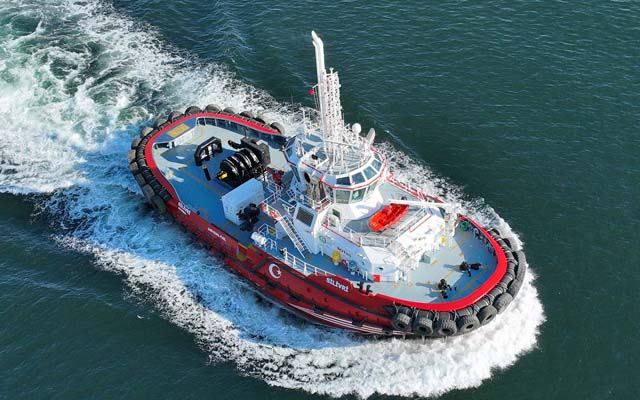The 39m tug ‘Silivri’, a TRAktor V3900-DF design from Robert Allan Ltd (RAL) of Canada, has been successfully delivered to the Botas Petroleum Pipeline Corporation in Türkiye from the Uzmar Shipyard.
Silivri is only the second vessel to combine Voith Schneider propulsion with dual-fuel LNG/diesel engines, following sistership Sultanhani, delivered earlier in 2025 to the same owner.
Equipped with Wärtsilä 6L34DF engines and 32X6 Voith Schneider propellers (VSPs), Silivri can undertake challenging escort operations as part of Botas’ fleet. VSPs are suited for this application due to their fast response time and precise manoeuvring. The 32X6 VSP model is the latest innovation in the cycloidal propeller portfolio, featuring several improvements over its predecessors, not least of which is a simplified yet more robust design. The TRAktor V3900-DF series features a new geometry for the VSP guard plate, optimising bollard pull performance and simplifying construction.
The Wärtsilä 6L34DF dual fuel engine can run on either LNG or diesel, with seamless transition between the two fuels. An exhaust aftertreatment arrangement consisting of SCR units, mixing tubes, and a dedicated diesel exhaust fluid (DEF) system is installed to maintain IMO Tier III emission compliance. The 40 m3 LNG tank is fitted aft of the engine room in a dedicated compartment and is installed transversely allowing a more compact and efficient equipment arrangement, as well as separating associated hazardous zones from the accommodation block forward. A force ventilated LNG vent mast allows possible vented natural gas from the LNG tank and system to be well dispersed on exit, without the potential for cold vapour collapse. The vent mast locates the outlet well above the working deck and away from any crew areas or ventilation intakes.
Development of the TRAktor V3900-DF hull form included an extensive computational fluid dynamics (CFD) phase in which multiple operational parameters were optimised. Foremost among those was ensuring tug directional stability by installing RAL’s strake stabilisers at the stern. These small appendages ensure the tug is directionally stable yet still highly manoeuvrable, with minimal impact to resistance. During the design phase these results were verified in model tests and results were confirmed on sea trials.
Silivri can generate 80t of bollard pull and 107t of steering force during escort operations, and can achieve 188t of braking (more than twice the static bollard pull).
This represents the latest evolution of the design concept developed by RAL for LNG-fuelled tugs. It addresses the space and regulatory limitations specific to small vessels, which are not present in larger LNG-fuelled vessels. This design incorporates lessons learned and operational feedback from the 10 previous RAL LNG-fuelled tugs. Many of these design features are now being used as the foundation for future alternative-fuel tug designs under development at RAL.
The tug was designed and constructed to comply with all applicable Rules and Regulations of Bureau Veritas with the notation I ✠HULL, ✠MACH, ✠AUT-AMS, Escort Tug, Fire-Fighting 1 Water Spraying, Dual Fuel, LNG Fuel, In Water Survey, Unrestricted Navigation
Image: RAL-designed dual-fuel VSP-equipped escort tug (source: Robert Allan Ltd)



